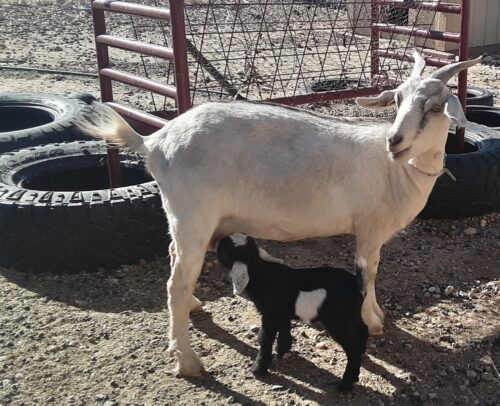
Phoenix here, continuing our series on dairy farming. In this post, I want to talk about some of the differences between goat milk and cow milk. But first, how do we get a goat to produce milk? We can’t just buy a goat and expect it to automatically start producing milk when it’s old enough.
Instead, here is the general process:
- First, we need to let the goats get pregnant. As long as you want milk, the goats will have to give birth, so you should have a plan to deal with the kids. People can rent bucks (males) or take their does (females) to someone who has a buck. This might be preferable for some because bucks take up space, especially if they need to be separated for part of the year if you want to limit birthing to the spring. They can also be destructive and/or aggressive, and can have a strong smell. If they are kept separate from the does, they need to have a wether (neutered male) for company since goats are herd animals. Another option is artificial insemination which may require multiple attempts, and issues around mailing sperm have to be addressed like temperature fluctuations that can destroy the sperm.
- In about 5 months, the kids will be born. They will need to nurse full-time for one or two weeks because at this stage the milk has colostrum, a high-fat and high-protein substance with antibodies the kids need to survive and become productive adults. Simple goat milk from the store will not provide the kid what it needs at this stage.
- We start milking the goats once a day after a week because the kids still need calories from the milk but there is less colostrum in the milk at this point. For this, we separate the kids from the mothers overnight. We do this for five weeks, at which point the kids are grazing or eating hay.
- Then we separate the kids full-time and milk the goats twice a day till they dry, which is around 4 months, depending on the type of goat.
- We repeat this process for as long as we want milk. This year, we are aiming for two birthings, one in spring and one in fall, hopefully providing us with fresh milk for at least 8 months. What do we do for the rest of the year? See later posts on what we do with milk and milk products.
Now that we’ve gone over the process of getting milk,…
What’s the difference between cow milk and goat milk?
- Butter fats are less homogenized in cow milk, which is good for separating cream from milk. Goat milk does not separate as easily. While there are cream separators, we have not found them to work for goat milk. Instead, we store milk in the fridge for a week and skim the small amount of cream that floats naturally to the top at the end of the week. This can be frozen until you collect enough to make butter, ice cream, etc.
- Goat milk has less lactose than cow milk, making it easier to digest, especially for people with lactose intolerance. Lactose intolerance develops when the body stops producing lactase, an enzyme necessary for breaking down lactose, the sugar found in milk. All animals, including humans, naturally go through this when they stop nursing. However, humans continue to drink milk from other animals even as adults. Some people may suffer from lactose intolerance as a result. Please note, this is different from a milk protein allergy.
- Goat milk has more Vitamin A, thiamine, and niacin than cow milk. It is also higher in calcium, potassium, magnesium, phosphorus, chlorine and manganese. Altogether, these help increase bone health, immune health, heart health, energy levels, and other matters.
Join me next time, when we’ll go over how to milk goats.
Next blog post: Part 3: Dairy Farming–milking the goats (by Phoenix)
